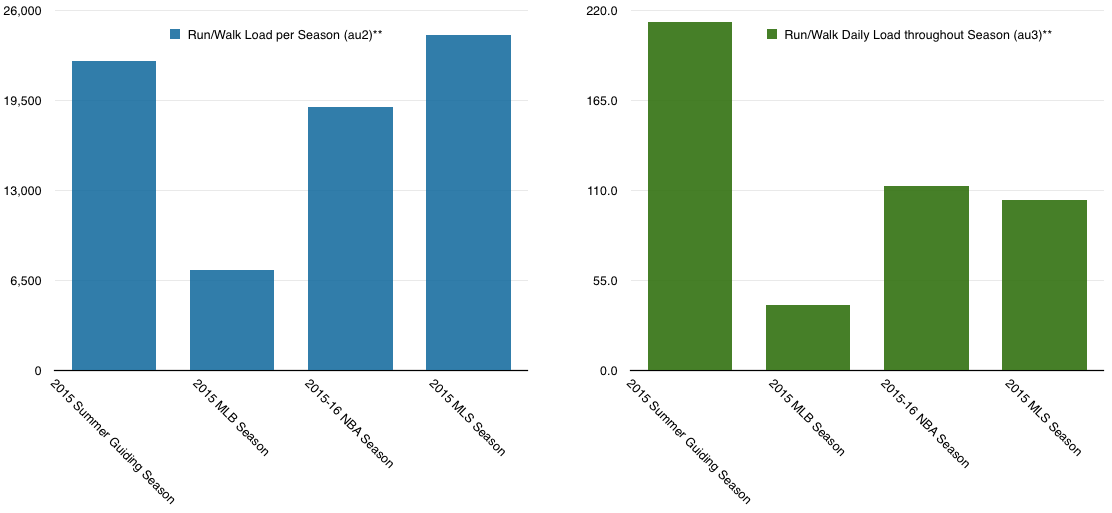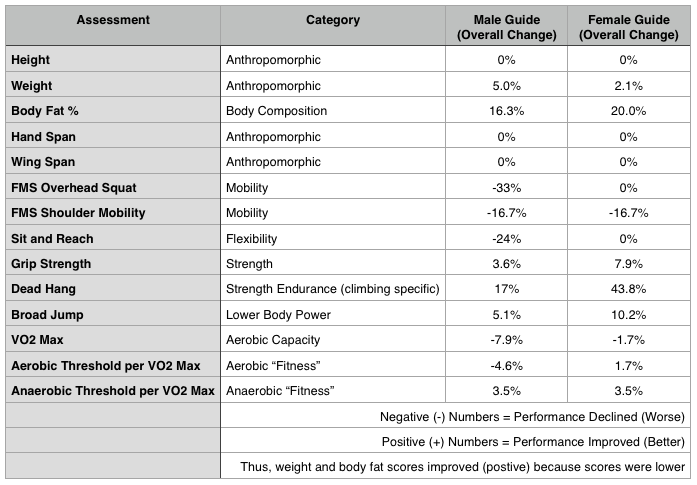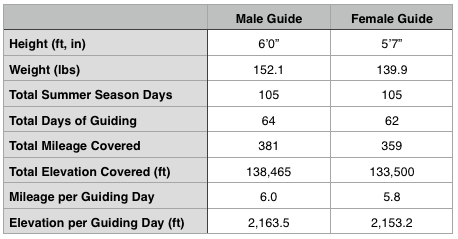This article was first published in September 2015
By Adam Scott, MS, CSCS
Here in Jackson, WY the summer guiding season typically goes from Memorial Day to Labor Day. For our professional mountain guides, this means a steady increase in work from the end of May through the beginning of September, with a peak during the month of August.
In 2015 the season lasted 105 days (May 25th through September 7th). During this time, the two guides we tested completed 64 and 62 total guiding trips. These trips accounted for a total distance 381 and 359 miles and a total elevation gain of approximately 138,465 ft and 133,500 ft, respectively.
Just for fun, we pulled data from a few professional sports seasons (MLB, NBA, MLS and NFL) to see how a season of guiding stacked-up. When comparing the sports we were only able to look at distances and intensities. This worked well for some sports, but obviously misses a few major components (jumping in Basketball, player-on-player contact in the NFL, etc.). Regardless, we thought it was an interesting comparison.
Estimated Loads per Competitive Seasons

Comparison of Loads Per Season and Per Day

Distances Per Sport: http://www.runnersworld.com/newswire/distance-run-per-game-in-various-sports
Soccer Speed: http://www.businessinsider.com/chart-soccer-players-run-miles-2014-6
Basketball HR (Intensity): http://www.jhse.ua.es/jhse/article/view/22/66
Soccer HR (Intensity): http://www.ncbi.nlm.nih.gov/pubmed/1895354
Based on total volume, our 105-day summer guiding seasons were on-par with the much longer, 233-day MLS and 169-day NBA seasons. Looking at the day-to-day load, summer guiding was by far the most physically demanding “sport” (based on distance and intensity). This was due mainly to our guides frequency of performance (once every 1.6 days) and duration (5.9 miles).
The Impact of Summer Guiding Season
In order to glean some insight into the physiological demand of the summer guiding season, we tested two of our guides at the beginning of the summer season (May 29th) and at the end (September 17th).
Testing for our guides was based on the physiological events in our Alpinist Fitness Assessment (AFA). We looked at anthropomorphic measures, body composition, mobility, flexibility, strength, power, aerobic fitness and anaerobic fitness.
Overall Impact (Percent Change)

Overall Impact (Percent Change)

As you can see, the summer season had a mixed effect on our guides.
On the positive side, both guides lost a considerable amount of body fat during the season (2.6kg and 2.0kg). Additionally, both male and female guides also improved their general strength and climbing-specific grip strength. Finally, based on their broad jump scores, both guides also drastically improved their lower-body power.
Anthropomorphic Test Results – Male (left) and Female (right)

Performance Test Results – Male (left) and Female (right)

On the negative side, our guides both saw decreases in flexibility and mobility. These declines were more pronounced in our male guide, who saw downturns in all three measures (FMS Overhead Squat, FMS Shoulder Mobility, and Sit and Reach). Our female guide regressed in her FMS Shoulder Mobility, but maintained her FMS Overhead Squat, and Sit and Reach performance. However, it should be pointed out that our female guide continued to practice yoga during the season as a supplement to her guiding.
The most unexpected results we found with our guides were their scores during the Treadmill VO2 Max Test. Both athletes saw slight declines in their aerobic capacity (VO2 Max). Results on their aerobic threshold scores were split (female guide slightly increased and male guide slightly decreased). However, both athletes saw moderate gains in their anaerobic threshold (3.5% increase for both).
The decreases in overall aerobic capacity and aerobic threshold were surprising. However, since, according to Dr. Len Kravitz, “[Anaerobic] threshold is the most important determinant of success in endurance-related activities and events” the increases in anaerobic threshold seem to support the fact that both guides are more aerobically fit despite their declines in aerobic capacity and threshold. Based on this it would have been interesting to see how our guides performed on the 15k run from the full AFA.
Of note, it is worth pointing out that both guides were recovering from respiratory illnesses during their testing, and this may have caused some complications in the data. Anecdotally, this could also be a sign of overtraining following their physiologically stressful season.
VO2 Max Test Results (Male and Female)

Recommendations
(1) Guides should approach their seasons similar to conventional professional athletes. This includes dedicated pre-season training, supplemental in-season training, and off-season training.
(2) Pre-season training for guides should be focused on building a strong aerobic capacity (VO2Max), durability, and work capacity. Establishing a strong foundation in these attributes will help since they seem to be most negatively effected during the season.
(3) In-season training should be built around maintaining and improving mobility and flexibility. With our guides completing a trip every 1.6 days there is very little room for in-season training. However, focusing on these two physical attributes should have a positive impact on performance without adding much additional physiological load.
(4) Guides need to pay careful attention to their nutrition and rest during the season. With little time between very physical demanding trips, recovery is at a premium. Keeping an eye on body composition and resting heart rate (measured immediately upon waking) are good ways to monitor recovery.
References
- Nieman, D.C., Fitness and sports medicine : a health-related approach. 3rd ed. 1995, Palo Alto, CA: Bull Pub. xxiii, 711 p.
- Massy-Westropp, N.M., et al., Hand Grip Strength: age and gender stratified normative data in a population-based study. BMC research notes, 2011. 4(1): p. 127.
- Grant, S., et al., Anthropometric, strength, endurance and flexibility characteristics of elite and recreational climbers. Journal of sports sciences, 1996. 14(4): p. 301-309.
- Watts, P.B., Physiology of difficult rock climbing. European journal of applied physiology, 2004. 91(4): p. 361-372.
- Franchini, E., et al., Physiological profiles of elite judo athletes. Sports Medicine, 2011. 41(2): p. 147-166.
- Leyk, D., et al., Hand-grip strength of young men, women and highly trained female athletes. European journal of applied physiology, 2007. 99(4): p. 415-421.
- Zlagboard – The door to your climbing world.
- Vescovi, J.D., T.M. Murray, and J.L. VanHeest, Positional performance profiling of elite ice hockey players. International journal of sports physiology and performance, 2006. 1(2): p. 84.
- Ransdell, L.B. and T. Murray, A physical profile of elite female ice hockey players from the USA. The Journal of Strength & Conditioning Research, 2011. 25(9): p. 2358-2363.
- Booth, J., et al., Energy cost of sport rock climbing in elite performers. British Journal of Sports Medicine, 1999. 33(1): p. 14-18.
- Baechle, T.R., R.W. Earle, and National Strength & Conditioning Association (U.S.), Essentials of strength training and conditioning. 2nd ed. 2000, Champaign, Ill.: Human Kinetics. xiii, 658 p.
- Tanner, R.K., C.J. Gore, and Australian Institute of Sport., Physiological tests for elite athletes. 2nd ed. 2013, Champaign, IL: Human Kinetics. xiv, 546 p.
- Kravitz, L. and Dalleck, L. Lactate Theshold Training. http://www.unm.edu/~lkravitz/Article%20folder/lactatethreshold.html


